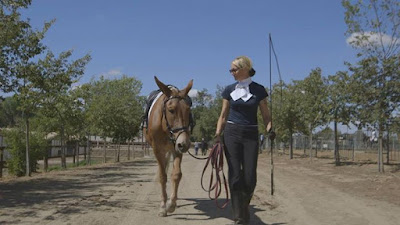Should I
blanket my horse, or should I leave him without a blanket? This is
an ongoing debate that has plagued the horse community for years.
Blanketing is common practice that is seen by many as a necessity.
If the owner is cold, they give their horse an extra layer so he can
keep warm. However, what many people do not realize is that in most
cases, blanketing is unnecessary, and in some cases detrimental.
Except for extreme conditions, such as old age, illness, heavy winds,
or when a horse has been body clipped, horses should not be
blanketed.
Horses are
incredibly adaptive creatures: they can live in the arid deserts like
that of Arabia, in the bitter cold, or just about any climate that
man has inhabited and brought horses. For centuries before
domestication, wild horses have been able to adapt to the climates
where they lived, and have never required the pampering that many
horse owners give their horses today. Feral horses of today are also
well enough adapted that they can stay warm enough in the winter,
providing they have enough food and a windbreak. Domesticated horses
are no different. They have many ways of regulating their body
temperature. The horse's digestive system produces heat as it digests
fibers found it hay and other feeds, and the horse's fat, skin, and
thick winter coat act as insulators, trapping the heat in to keep the
horse sufficiently warm. In a process called piloerection, the
horse's hair raises and lowers, depending on the temperature and wind
speed. This regulates the amount of heat that is trapped in.
Because of this, horses do not need blankets to help keep them warm.
Changes in the
coat occur automatically, and much more quickly than it would take
for someone to remove or replace a blanket. Because of this, a
blanketed horse can begin to overheat by the time the blanket is
removed when the daytime temperatures become warm. Furthermore,
blanketing actually interferes with the process thermoregulation. As
the horse tries to warm the exposed body parts, the blanketed parts
sweat and overheat. “Sweating under a blanket is more of a problem
metabolically to the horse than people realize”(Natalija). When
blanketed or stabled for extended periods of time, the metabolic
functions that control body temperature are not used–they do not
need to be. As a result, if the horse is exposed to cold temperature
after that, these function do not work as effectively. Consequently,
the horse will be unable to heat themselves and will be too cold.
Overheating or being too cold can cause a host of problems for the
horse, so it best that he keeps his body heat at comfortable
temperature.
As most horse
owners know, blankets, like all horse equipment, are expensive.
Depending on where you live, you may even have to buy multiple
blankets to used during large changes in temperature, because once a
horse is blanketed regularly, they do not have a winter coat to keep
them warm. They may require a thick, heavy blanket when it is icy,
rainy, and windy, but only a medium-weight blanket in more moderate
temperatures. Furthermore, one must consider the cost of replacing
broken blankets. Some horses, especially younger ones, are
destructive with their blankets. Even blankets not used by horses
who intentionally destroy blankets can break as a result of the rough
treatment it gets from horses rolling and playing. If the horse is
left uncovered however, you will probably only need to buy a light
blanket for the coldest, wettest, and windiest days. As a result,
you will save money because you will not need to spend as much money
on blankets as you would if you blanketed your horse regularly.
Since horses
can regulate their body temperature so well, even if temperatures
that people find chilling and uncomfortable to be in, they do not
need to be blanketed, as long as they are healthy, have enough food,
have a windbreak, and are unclipped. Keeping the horses uncovered in
the winter may also save the you money because you will not need to
purchase blankets for your horses. For these reasons, blanketing is
unnatural and unnecessary, unless the horse in unhealthy, clipped, or
unadjusted to the climate, or if the weather is particularly
inhospitable.
Bibliography
Aleksandrova,
Natalija. “No More Blankets–An Amazing Article.” The Soul of
a Horse.
2015.
1 Dec. 2015.
http://thesoulofahorse.com/blog/no-more-blankets-an-amazing-article/
Krahl,
Stephanie. To Blanket Your Horse or Not to Blanket...That Is the
Question. The
Soulful Equine.
2015. 1 Dec. 2015.
http://www.soulfulequine.com/to-blanket-your-horse-or-not-to-blanket-that-is-the-question/
Williams,
Carey A. Ph.D. and Ralston, Sarah L. VMD, Ph.D. Did You Know: Winter
Care and Feeding. My
Horse University.
2012. 1 Dec. 2015.
http://www.myhorseuniversity.com/resources/eTips/November2011/Didyouknow























